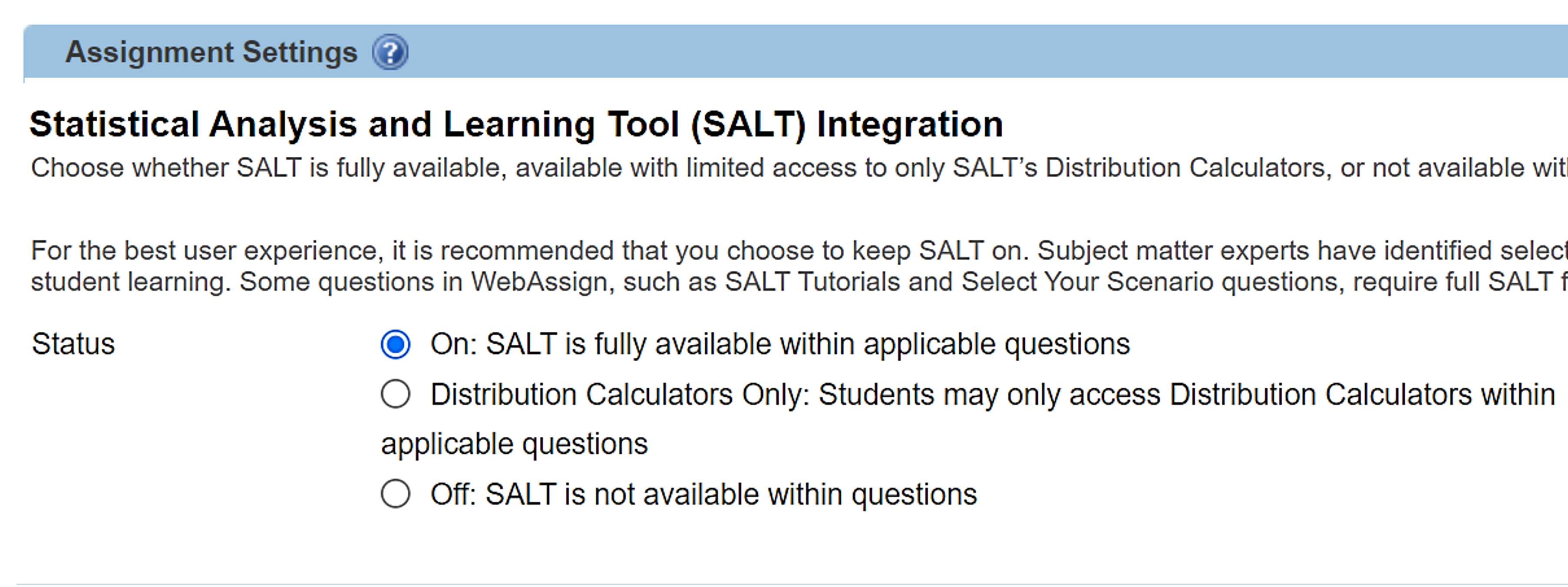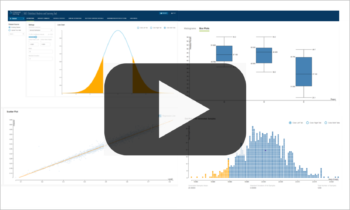How do you get your students to understand the meaning behind data in order to think statistically?
The Statistical Analysis and Learning Tool (SALT) is designed by statisticians, for statisticians, to help you get introductory students deeply engaged in data manipulation, analysis, and interpretation without getting bogged down in complex computations. After years of development in partnership with statistics educators and in-class testing by instructors and students, SALT is fully integrated into WebAssign questions.
The result? Engaged students able to visualize statistics with a deeper conceptual understanding of the meaning behind data.
New Feature: Determine How SALT Appears in Your Assignments
New for fall 2022, you can determine how you want the Statistical Analysis and Learning Tool (SALT) to appear in your assignments, including the ability to turn the tool off.
 Within your assignment settings, you can customize whether you want students to have access to SALT, a simplified version of SALT with just the distributions calculator or turn SALT off completely.
Within your assignment settings, you can customize whether you want students to have access to SALT, a simplified version of SALT with just the distributions calculator or turn SALT off completely.
SALT Features | SALT in Action | Getting Started | FAQ | Datasets
| What’s New
Access Seamlessly
- With just one click, datasets within applicable WebAssign questions are automatically imported for students to manipulate within SALT
- Instructors can choose to access SALT at a standalone website to quickly access for instructional and testing purposes – in and out of the classroom
- Students can access SALT at a standalone website once their course has ended for use in their subsequent courses or projects
Fuel Student Learning
- Dynamic graphics and a modern interface with easy-to-use controls helps students intuitively manipulate and visualize datasets to gain a deeper understanding across graphing, descriptive statistics, hypothesis testing, distributions, regression, sampling, and more
- Interesting, relevant datasets peek student interest and engage them in where statistics applies in real life – or you can use your own!
– Wendiann Sethi, PhD. Instructor at Seton Hall University & SALT beta tester
SALT Features
What features are available in SALT
Access the full list of current features available in SALT here. Note this link will be continually updated as more features are available.
SALT in Action
SALT - Charts and Graphs
SALT - Distributions
Getting Started
SALT Online Help Documentation
INSTRUCTOR - Top Tips for Using SALT
Review the top tips here.
INSTRUCTOR – Introduction to SALT
STUDENT - Datasets
STUDENT – Charts and Graphs
STUDENT – Distribution Calculators
STUDENT - Sampling
STUDENT – Inferential Statistics
STUDENT – Regression
FAQ
What is SALT?
A data analysis tool for introductory level statistics courses that helps students gain improved conceptual understanding of statistics through:
- Visualization of data
- Analyzation of data and performing a wide variety of statistical procedures
- Ease of use so students spend time learning statistics, not how to use a data analysis tool
What if I use other data analysis tools in my class already?
SALT can be used standalone or in conjunction with other data analysis tools.
Additionally, WebAssign contains Statistical Labs which support use with SPSS, JMP, Minitab, R, Graphing Calculator, Excel and SALT. Comprehensive Tech Guides are also available for additional student support.
Is SALT built from a pre-existing tool? Or, is it created solely by Cengage?
SALT was created by Cengage, with the mission of building a data analysis tool that helps make statistics accessible and understandable to introductory-level students. It was created in collaboration with in-house subject matter experts that have years of experience using other data analysis tools, an advisory board of statistics faculty, and feedback from our beta program over 2 semesters of usage. SALT contains the most important statistical functions while being very easy to use.
How do I add SALT to my course?
If you are creating new assignments and would like to add questions with SALT, SALT questions are marked with a “.S” extension when viewing questions from the WebAssign Question Browser. A large USE SALT button will also be visible when previewing the question.
If you have an existing WebAssign course, we will automatically upgrade the questions within your assignments to include SALT for you. Approximately 33% of questions have been upgraded to automatically include SALT.
Will having SALT in my WebAssign course increase the price for my students?
No, pricing will remain the same.
Which titles will include SALT integrated questions?
SALT-integrated questions are included in the following titles:
- Cengage, Statistics by Learning Objective
- Brase/Brase, Understanding Basic Statistics, 8e
- Brase/Brase, Understandable Statistics: Concepts and Methods, 12e
- Brase/Brase, Understandable Statistics: Concepts and Methods, 13e
- Devore, Probability and Statistics for Engineering and the Sciences, 9e
- Mendenhall/Beaver/Beaver, Introduction to Probability and Statistics, 15e
- Peck/Short, Statistics: Learning from Data, 2e
- Peck/Olsen/Short, Introduction to Statistics and Data Analysis, 6e
- Rosner, Fundamentals of Biostatistics, 8e
- Utts/Heckard, Mind on Statistics, 5e
- Utts/Heckard, Mind on Statistics, 6e
- Utts, Seeing Through Statistics, 4e
Is SALT available to access outside of WebAssign?
SALT is available at statistics.cengage.com. It is the same statistical analysis tool that is available inside of WebAssign. Faculty and students can upload their own datasets into it, and it will also come pre-loaded with datasets curated by Cengage.
What graph types are supported by SALT?
Types of graphs available now include:
- Bar charts
- Stacked bar charts
- Pie charts
- Histograms
- Box plots
- Scatter plots
- Normal probability plots
- Dot plot
- Scatter plot
On our future roadmap:
- Comparative bar charts
- Frequency tables
- Relative frequency tables
Additional graphs will be added over time.
Can students use SALT after the semester is over?
SALT is free to access from statistics.cengage.com.
Can I upload my own datasets into SALT?
Yes, you may upload your own datasets as CSV files.
Will SALT work in LockDown browser?
Yes. You can use LockDown browser, which can be downloaded through WebAssign. SALT can also be used for paper and pencil testing, outside of WebAssign, by going to statistics.cengage.com, and uploading your own data sets.
What methodology is used to select which questions have SALT?
Approximately 33% of existing Cengage Statistics questions in WebAssign have been converted to automatically include SALT, and more will be added over time. SALT will be included for all questions where:
-
- The problem involves a statistical function supported by SALT
- The problem involves both computational and interpretive parts.
Questions which are purely computational or purely conceptual without a computational aspect will not typically include SALT for pedagogical reasons.
Students will interact with a variety of tabs in SALT including:
- Dataset
- Descriptive Statistics
- Charts and Graphs
- Distribution Calculators
- Sampling
- Inferential Statistics
- Bootstrap Confidence Intervals
- Randomization Hypothesis Testing
- Regression
For WebAssign-integrated SALT questions, we optimize the user experience for students by directing them to the tab most logical for answering the question.
Is SALT ADA compliant?
Cengage Learning is committed to providing comprehensive and accessible learning environments for all learners. This includes standalone SALT and SALT with WebAssign. In our efforts to meet accessibility requirements for learning disabilities, we are committed to continuously working to improve the experience in SALT.
We are working to strengthen the design of SALT, implementing strategies to enhance the overall accessibility of the tool.
Can students export their work from SALT?
Students can use screen capture functionality to grab an image of their work and upload it into WebAssign, at the question level, using the Show My Work feature in WebAssign. In the future, we are considering adding a separate Export feature into SALT.
What’s new in SALT?
Latest Improvements (2021)
- Usability Updates
- Null hypothesis proportions for Chi Square Goodness of Fit
- One-Way ANOVA tests
- Added Normal Probability Plots
- Distribution Page Improvements
- Improved Segmented Bar Chart and Stacked Bar Charts
- Created comparative bar charts
- Chi Square Distribution
How can I give feedback on SALT?
To provide feedback, please take this survey.
Datasets
Cengage Dataset Hub
A trusted source for interesting and curated datasets which can be used with any data analysis tool, including SALT. Explore Now.
What's New
2022 Improvements
Determine How SALT Appears in Your Assignments
New for fall 2022, you can determine how you want the Statistical Analysis and Learning Tool (SALT) to appear in your assignments, including the ability to turn the tool off.

Within your assignment settings, you can customize whether you want students to have access to SALT, a simplified version of SALT with just the distributions calculator or turn SALT off completely.
2021 Improvements
Latest Improvements (2021)
- Usability Updates
- Null hypothesis proportions for Chi Square Goodness of Fit
- One-Way ANOVA tests
- Added Normal Probability Plots
- Distribution Page Improvements
- Improved Segmented Bar Chart and Stacked Bar Charts
- Created comparative bar charts
- Chi Square Distribution
2020 Updates
The following improvements have been made from August 2020 to October 2020:
- Ability to add and search for data on data set page
- Data Set import improvements
- Display of data on data set page improvements
